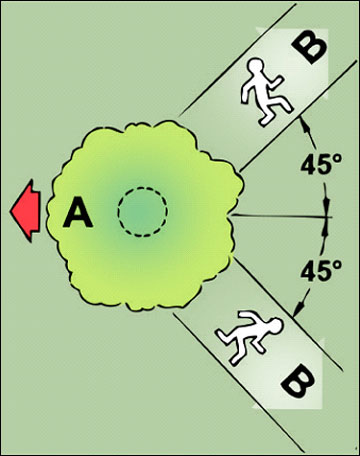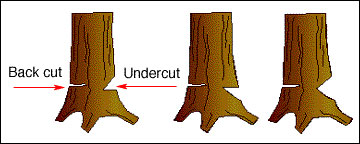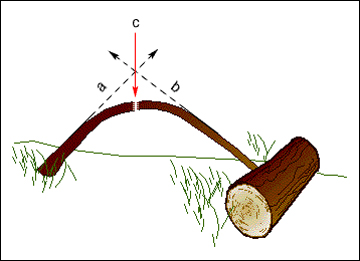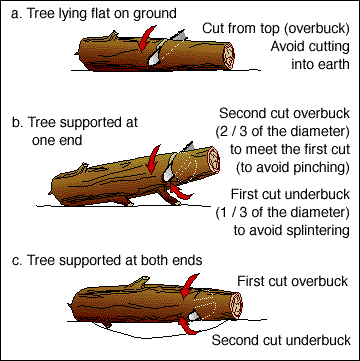Whether you are using a chain saw to cut firewood, trim trees or harvest large timber, you will be performing three basic operations: felling, limbing and bucking. Felling involves cutting a standing tree and dropping it in the place you want it. Limbing is the removal of the branches from either standing or downed trees. Bucking is the process of cutting a downed tree into appropriate lengths.
For information on the selection, maintenance and safe use of a chain saw, see MU Extension publications G1954, Selecting and Maintaining a Chain Saw, and G1959, Operating a Chain Saw Safely.
Felling a tree
Felling a tree can literally make or break your day. Landing a tree where you want it facilitates the rest of your operations. Many people cutting firewood have dropped trees on their pickup trucks.
Examine the tree and its surroundings
Note any uneven distribution of branches in the tree crown, lean of the trunk and signs of rot or decay. Inexperienced tree cutters should never attempt to cut trees that are decayed or rotted inside or that are leaning or otherwise under tension. Such trees are at greater risk of snapping or splitting while being cut, which could cause serious or fatal injury to the cutter or bystanders.
If power lines are in the vicinity of the tree, do not attempt to fell the tree unless you are absolutely certain that doing so will not interfere with them. If the tree must be removed and you suspect felling it will affect a power line, call the power company. They will have the expertise and equipment to remove the tree safely.
Examine the tree for loose, dead limbs. Loose limbs that fall onto the tree cutter are a common cause of serious injuries and fatalities. Remove loose limbs before felling, if possible. If that’s not possible, fell the tree from a position where the limbs could not strike you if dislodged.
Note the position of nearby trees. Be sure that the tree you are felling can fall all the way to the ground. A lodged tree is very dangerous. Experienced loggers are often killed by felled trees that hang up or snag in adjacent trees. A tree spring-back from the weight of a falling tree can whip a broken limb toward the cutter or bystanders with tremendous speed.
Plan two escape paths

Plan two escape paths (B) opposite the planned direction of the fall of the tree (A) and at about a 45 angle from each other (Figure 1). Remove all obstacles from the paths. Place all tools and equipment a safe distance away from the tree but not on the escape paths. Select a place to set the chain saw in case of emergency. Never run while holding a chain saw, operating or not. Rather, turn off the chain saw and set it down before making your escape.
Make the cut
Clear a safe work area around the base of the tree. Remove limbs, underbrush and other obstructions, being sure to keep your escape paths clear.
Ensure all bystanders are a safe distance from the base of the tree to be felled, at least 1-1/2 times the height of the tree, before the first cut is made.
For trees 6 inches in diameter or less, make one cut through the trunk. For larger diameter trees, the inexperienced chain saw operator should make two basic cuts: the undercut and the back cut. Advanced cutting techniques, such as plunge cutting, should only be done by experienced, professional loggers.
Undercut
The undercut serves as the guiding or aiming slot for the tree. Basically it is a V-shaped notch placed on the side of the tree in the direction of falling (Figure 2). Either a standard undercut (Figure 2a) or a reverse undercut (Figure 2b) can be used. Typically the first cut is made parallel to the ground and then the slanting cut is made.


A modified undercut known as an open-faced undercut has become popular in many areas (Figure 2c). Introduced by Scandinavian felling specialists, this cut is easier to make, provides good guidance and has additional safety features. Instead of ending up with a 45-degree opening, the undercut provides a nearly 90-degree opening. When the tree starts to fall, this modified undercut allows additional room for the tree to fall before the top and bottom of the undercut come together.
For trees that are essentially straight, the depth of the undercut should be about one-fourth of the tree’s diameter.
Back cut
For all three undercuts, the back cut is made on the opposite side of the tree, slightly above the hinge point of the undercut (Figure 2). The back cut releases the stresses on the back of the tree, allowing the tree to fall. Never make the back cut lower than the undercut because that reverses the roles of the two cuts. Never cut through the undercut because that will cause you to lose all control over the tree.
As the saw nears the undercut, leave a small amount of wood to serve as the “hinge” or “holding” wood (Figure 3). The tree actually pivots on this hinge, and the width and angle of the hinge can be used to guide the direction of the tree’s fall. Because of the angled hinge, the tree will start to fall on the narrow section of the hinge while the wood at the thicker section of the hinge is still intact. The tree is therefore pulled toward the thick section. Making these cuts is an art and requires practice.
Once the tree starts to fall, turn off the saw and move down your chosen escape path. Do not stand at the base of the tree to admire your work. Falling trees have been known to bounce backward over the stump and injure an unwary operator.
A leaning tree presents special problems. The difficulty of these problems depends on the direction and the degree of the lean. With a conventional back cut, a leaning tree will quite possibly split and fall prematurely. Rather than risk potential serious injury to yourself by trying to fell a leaning tree, consult a professional arborist.
Limbing a tree
When removing unwanted limbs from standing timber, the basic safety rule is: Never limb above your shoulders; that is, do not attempt to cut off branches above the height of your shoulders. Cutting above your shoulders requires that you hold the chain saw at or near arm’s length, and you lose control over the saw in this position. Proper limbing techniques to reduce damage to the tree are covered in MU Extension publications G5160, Pruning Forest Trees, and G6866, Pruning and Care of Shade Trees.
When limbing a tree that is lying on the ground, other safety rules apply. The first thing you should do is evaluate the fallen tree. If the tree has become lodged or wedged in adjacent trees and has not fallen all the way to the ground, do not walk underneath the tree. It may fall without warning. Trees that are “hung” are especially dangerous and need to be removed by mechanical means. They can be pulled down with a cable and a tractor suitably equipped to protect against roll-over and falling objects.
Besides checking whether the felled tree is hung, also consider the following questions as you survey the area:
- Do you see smaller trees that have been bent over and trapped by the felled tree?
- Do you see branches holding the tree partially in the air?
- Is the tree on level ground?
- If you have just felled the tree, are there dead branches or other debris hanging above you that may still fall to the ground?
Dead branches and debris are called widowmakers for good reason. They have been known to fall several minutes after a tree has been felled and severely injure or kill saw operators. To be safe, wait a few minutes to allow any additional debris to fall to the ground. Use the time to take a short rest.
Once you have evaluated the obstacles and hazards and are ready to limb the tree, stand on the uphill side of the tree. Never stand on the downhill side of a fallen log. If you cut a branch that is holding the log in place, the log could roll downhill and trap you. Make sure you have good footing and are standing in a balanced position that allows you freedom of movement
Start at the bottom of the tree and work your way to the top, removing branches on the opposite side of the tree from you as you go. Whenever possible, always cut on the side of the log opposite from you. This places the log between you and the saw and provides additional protection for you.
Keep sight of the tip of the saw to prevent kickback. Periodically put down the saw and remove debris so you have clear vision and movement around the tree.
Try to cut the limbs off as flush as possible with the trunk of the log. Doing this makes the log much easier to roll or move. If the limbs are in a position where flush cuts are not immediately possible, remember to remove the branch stubs later.
Depending on the species and size of the tree you are limbing, some of the branches may be very heavy. When heavy branches are removed from a log, the log may shift its position unexpectedly.

Smaller trees that are bent over and trapped by the weight of the fallen log are called springpoles. Springpoles have a tremendous amount of stored energy and present one of the greatest hazards of the limbing process. This energy can be safely removed by using an ax or chain saw to cut the springpole at the apex of its bend. Figure 4 illustrates how to locate the apex of a springpole. Trapped branches can also be springpoles and can be dealt with in the same way.
When cutting a tree into firewood, you may want to start at the top of the tree so that some of the branches are off the ground. That way, the wood drops to the ground and the saw is kept away from the ground as much as possible. Again, this is a time when good footing, good balance and ease of movement are especially important.
Bucking a tree


The process of cutting a tree into usable lengths is called bucking. Bucking often occurs as a tree is being limbed, such as when the limbs of the crown are to be used as firewood. When cutting firewood, make sure you know the needed length of wood before you leave home. When cutting full-size products, such as sawlogs and veneer logs, you must cut logs longer than the final product to leave a trim allowance. For an 8-foot log, a trim allowance of 4 to 6 inches is common. Many bucking cuts are angled, and the trim allowance allows the ends of the boards to be cut square at the mill to the desired board lengths.
When a tree is totally on level ground, the biggest problem during bucking is avoiding running the saw chain into the earth. When a tree is suspended at one end, the bucking operation becomes more difficult. Figure 5 shows various bucking techniques. In all cases, stand on the uphill side of the log and keep a firm grip on the saw with both hands. Also, keep a strong, even stance on the ground so you can move quickly if the log starts to roll.
A sawbuck can make bucking easier. It holds a log still at a good working height so that you can safely cut the wood to length (Figure 6). You can find plans for building a sawbuck in your local library or your chain saw owner’s manual, or you can purchase a sawbuck from a variety of sources.
Electrically powered chain saws
Electrically powered chain saws require some additional precautions. Use only a three-wire cord of the proper size with three-pronged plugs and a grounded three-wire outlet. A ground fault interrupter in the power supply line will help prevent fatal shocks.
The soil in the working area should be relatively dry. Avoid working in areas where the foliage or ground is wet.
Lay out the cord so that it will not interfere with your work. Take care to place it where you won’t inadvertently cut it with the saw or trip over it.
Make sure that the saw switch is in the off position before completing the electrical connection. Always unplug the saw before making adjustments and when the saw is not being used.